Welcome to our guide on the enchanting aquatic plant Phyllanthus Fluitans.
This captivating red root floater, also known as a floating plant, is a tropical beauty that adds elegance and vibrancy to any aquarium.
Join us as we dive into the fascinating world of Phyllanthus Fluitans, exploring its origins, care requirements, unique characteristics, and more.
Key Takeaway
- Phyllanthus Fluitans, also known as red root floater, is a stunning floating plant for tropical aquariums.
- This aquatic plant is easy to care for, making it suitable for both beginners and experienced aquarium enthusiasts.
- Phyllanthus Fluitans thrives in warm water with nutrient-rich conditions and prefers bright to indirect lighting.
- It offers unique characteristics, such as vibrant red roots and foliage, and provides benefits to aquatic ecosystems.
- Phyllanthus Fluitans can be combined with compatible fish, invertebrates, and other plants for visually appealing compositions when designing aquascapes.
Quick Stats
| Attribute | Details |
| Family Name | Phyllanthaceae |
| Origin | South America |
| Height | 2-3 cm (0.8-1.2 inches) above the water surface |
| pH Range | 6.0 – 7.5 |
| CO2 Requirement | Low |
| Growth Rate | Fast |
| Care Level | Easy |
| Color Form | Green leaves with vibrant red roots |
| Water Conditions | 20-28°C (68-82°F), adaptable to a wide range of water hardness |
| Max Size | Rosettes can spread indefinitely, but individual plants remain small |
| Lighting | Low to Moderate |
| Supplements | Minimal; benefits from nutrient-rich water |
| Placement | Floating |
| Propagation | Reproduces rapidly through side shoots and daughter plants |
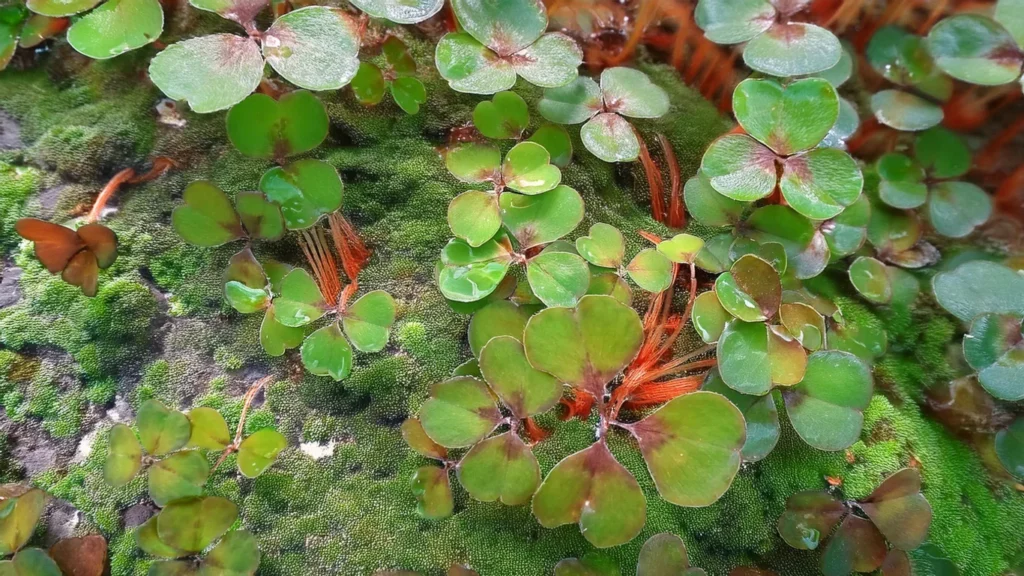
What Is Phyllanthus Fluitans?
Phyllanthus Fluitans is a floating plant species belonging to the Phyllanthaceae family.
It is native to tropical regions and is known for its vibrant red roots and foliage.
This floating beauty is highly sought after for its aesthetic appeal and ease of care, making it a popular choice among aquarium enthusiasts.
Natural Habitat Of Phyllanthus Fluitans
- Phyllanthus Fluitans thrives in calm and stagnant water bodies such as ponds, lakes, and marshes. Its natural habitat includes countries like Brazil, Argentina, and Paraguay. This aquatic plant prefers warm water temperatures ranging from 68 to 86 degrees Fahrenheit.
- Phyllanthus Fluitans can adapt to both bright and indirect lighting conditions, making it versatile for various aquarium setups. It requires nutrient-rich water and benefits from the presence of organic matter.
Unique Characteristics Of Phyllanthus Fluitans
- Phyllanthus Fluitans, also known as red root floater, possesses several unique characteristics that make it a captivating addition to any aquarium. One of its most defining features is its distinctive red roots and foliage. The vibrant red accents of Phyllanthus Fluitans add an eye-catching element to aquascapes, creating a visually stunning display.
- Aside from its striking appearance, Phyllanthus Fluitans offers numerous benefits to aquatic ecosystems. This floating plant helps to oxygenate the water, ensuring a healthy environment for fish and other aquatic organisms. Additionally, it assists in reducing excess nutrients, preventing the overgrowth of algae, and maintaining water quality.
- Phyllanthus Fluitans also provide hiding places for fish and invertebrates, promoting security and enhancing their natural behavior. Furthermore, its floating nature creates shade and shelter for other plants, contributing to the overall balance and biodiversity of the aquatic environment.
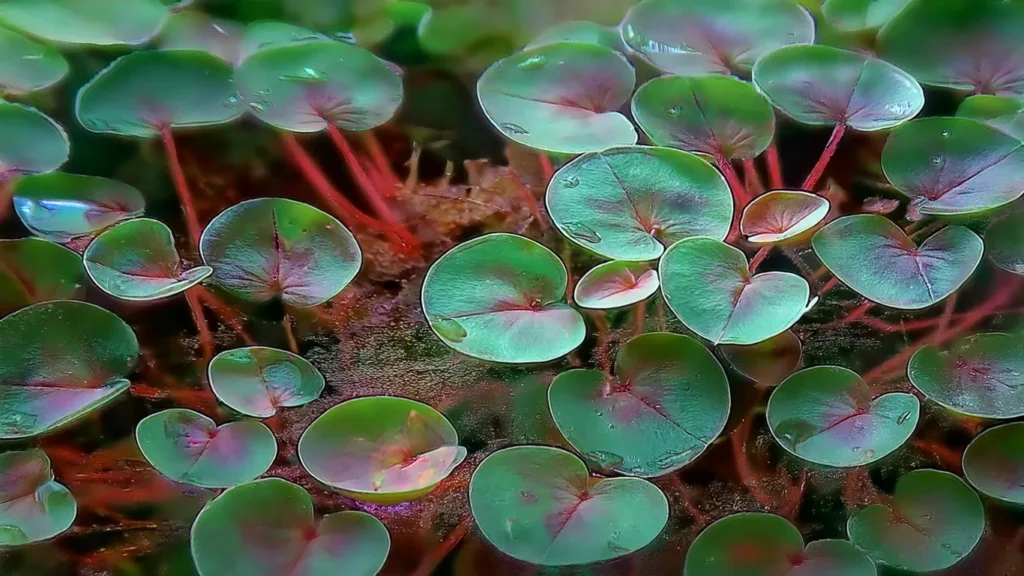
Lighting Needs
- Moderate to High Intensity: Phyllanthus fluitans typically thrives under moderate to high lighting conditions. Providing adequate light intensity is essential for promoting healthy growth and vibrant coloration in this floating plant.
- Duration: Aim for a photoperiod of around 8 to 10 hours per day. Consistent lighting schedules help mimic natural daylight cycles and support the plant’s growth and metabolic processes.
- Quality Spectrum: Use a lighting system that emits a balanced spectrum of light, including both blue and red wavelengths. This spectrum closely resembles natural sunlight and promotes optimal photosynthesis and growth in aquatic plants.
- Adjustable Lighting: Depending on your tank’s specific requirements and the presence of other plants, you may need to adjust the intensity and duration of the lighting to prevent issues such as algae overgrowth or excessive shading.
- Avoid Excessive Heat: Ensure that the lighting system does not generate excessive heat, as this can lead to elevated water temperatures and potential stress for the plants and other tank inhabitants.
Temperature Parameter
The optimal temperature range for Phyllanthus fluitans, commonly known as Red Root Floater, is typically between 72°F to 82°F (22°C to 28°C).
Maintaining water temperatures within this range promotes healthy growth and helps to prevent stress-related issues.
Ensure stability in temperature to support the overall well-being of this floating plant species.
Optimal Water Condition
- pH Range: Aim to keep the pH level within the range of 6.0 to 7.5. This slightly acidic to neutral pH range mimics the plant’s natural habitat and supports nutrient uptake and overall health.
- Water Hardness: Moderate water hardness is preferred, with a general hardness (GH) level between 5 to 15 degrees dGH. This range ensures the availability of essential minerals while preventing excessive mineral buildup, which can hinder plant growth.
- Temperature Range: Maintain water temperatures between 72°F to 82°F (22°C to 28°C). This range provides an ideal balance between warmth and coolness, promoting robust growth and preventing temperature-related stress.
- Stability: Consistency is key when it comes to water parameters. Fluctuations in pH, hardness, or temperature can stress the plants and compromise their health. Regular monitoring and adjustments, if necessary, help maintain stable water conditions.
- Filtration: Effective filtration is essential for maintaining water quality and clarity in the aquarium. A good filtration system helps remove excess nutrients, waste, and debris, preventing them from accumulating and negatively impacting plant health.

Substrate Requirement
- Nutrient Availability: Even though Red Root Floater primarily absorbs nutrients from the water column, a nutrient-rich substrate can still benefit other plants in the aquarium.
- like iron, potassium, and trace elements to support plant growth.
- Substrate Type: Opt for a fine-grained substrate like aqua soil or nutrient-rich substrate tablets that can release nutrients gradually over time. These substrates provide a stable base for rooted plants and help maintain water chemistry.
- Root Health: Although Red Root Floater doesn’t have roots that anchor into the substrate, a healthy substrate can indirectly benefit other plants with root systems. Ensure proper aeration and substrate depth to prevent anaerobic conditions, which can lead to root rot and nutrient imbalances.
- Aesthetic Considerations: While not directly related to Red Root Floater, the substrate can contribute to the overall aesthetics of the aquarium. Choose a substrate color and texture that complements the plant’s vibrant red roots and enhances the visual appeal of the tank.
Placement Option
- Floating Plant: Red Root Floater is a floating plant species, meaning it doesn’t need to be planted in substrate. Instead, it floats on the surface of the water, where it absorbs nutrients directly from the water column.
- Surface Coverage: Place Red Root Floater in areas of the aquarium where it can freely spread across the surface of the water. This plant can provide shade and shelter for fish and other aquatic life, so distributing it evenly across the surface can benefit the entire tank ecosystem.
- Avoid Blockage: Be mindful of filter intakes and outflows when placing Red Root Floater. Avoid blocking these areas with dense mats of floating plants, as it can impede water flow and reduce the efficiency of filtration.
- Lighting Considerations: Red Root Floater thrives in moderate to high lighting conditions. Place it in areas of the aquarium where it can receive sufficient light for photosynthesis, but be cautious of excessive direct light, which can lead to algae growth.
- Compatible Plants: Consider the compatibility of Red Root Floater with other plants in your aquarium. Avoid placing it in areas where it may shade out or compete with lower-lying plants that require direct light.
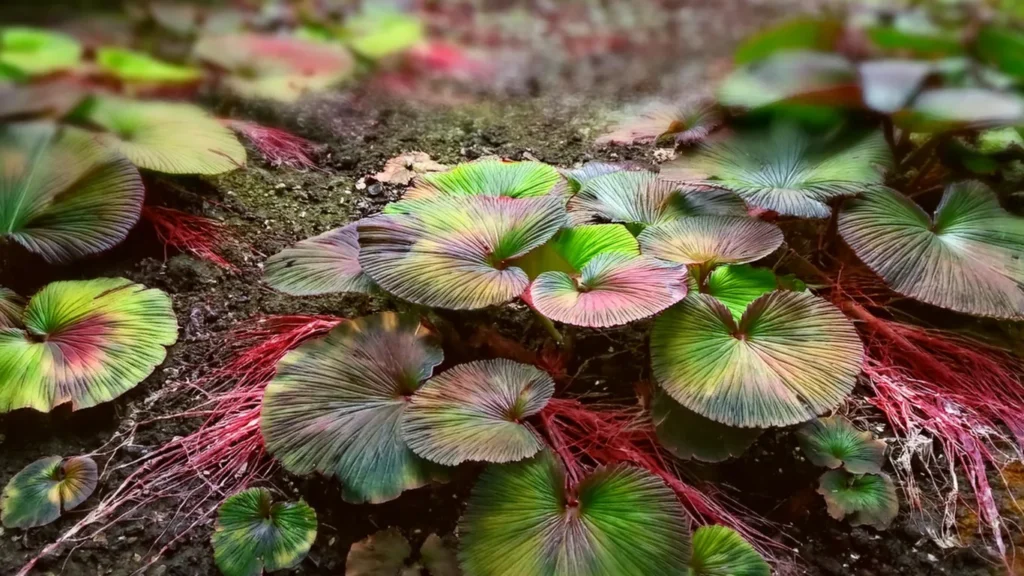
Recommended Tank Size
- Nano Tanks: Red Root Floater can thrive in small nano tanks with capacities of 5 gallons (19 liters) or more. These tanks provide enough space for the plant to spread across the surface while still leaving room for fish and other aquatic inhabitants.
- Medium Tanks: For medium-sized tanks ranging from 20 to 50 gallons (75 to 189 liters), Red Root Floater can be used as a versatile floating plant to provide shade and cover for fish and other plants.
- Large Tanks: In larger aquarium setups exceeding 50 gallons (189 liters), Red Root Floater can be used effectively to cover larger surface areas, creating natural-looking floating mats and enhancing the overall aesthetics of the tank.
Ideal Tank Mates
- Incorporating compatible plants into your aquascape alongside Phyllanthus Fluitans can enhance the overall aesthetic and create a visually stunning display.
- Consider plant varieties like Amazon swords, Java ferns, and Anubias, which complement the floating beauty of Phyllanthus Fluitans and add depth to your aquatic design.
- These plant pairings can create a lush and captivating underwater landscape that is pleasing to the eye and provides a natural habitat for fish and invertebrates.
- When choosing tank mates for Phyllanthus Fluitans, it’s crucial to consider their compatibility regarding water parameters and behavior. Opt for peaceful fish species, such as tetras, rasboras, and guppies that won’t harass or harm the delicate floating plant.
- Invertebrates like shrimp and snails also make excellent companions, as they have minimal impact on the plant’s growth and can coexist harmoniously in the same tank.
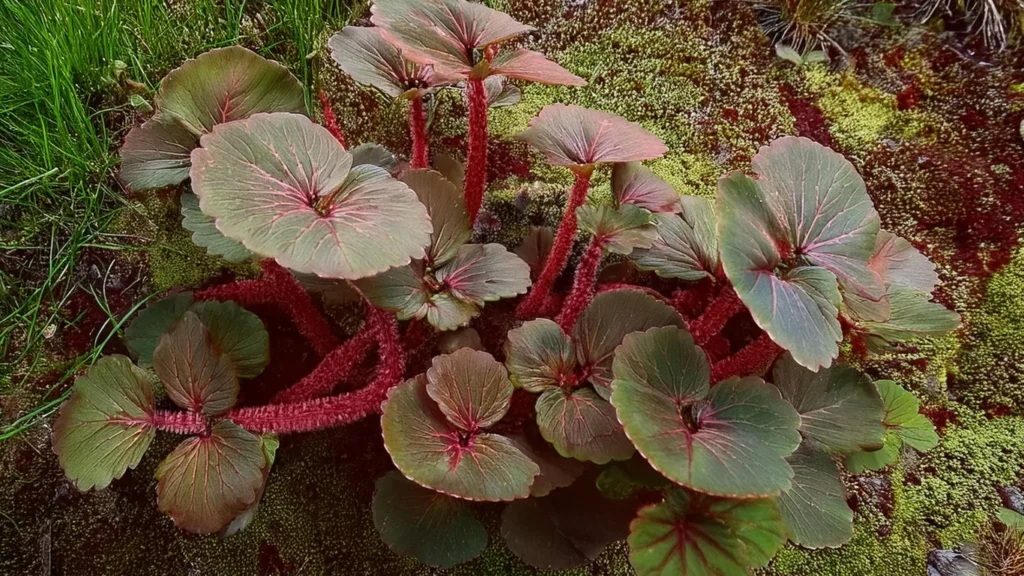
Nutritional Needs
- Macronutrients: Red Root Floater requires essential macronutrients such as nitrogen (N), phosphorus (P), and potassium (K) for healthy growth. These nutrients can be supplemented through fish waste, fish food, and fertilizers.
- Micronutrients: In addition to macronutrients, Red Root Floater also benefits from essential micronutrients such as iron (Fe), manganese (Mn), and zinc (Zn). These micronutrients can be provided through a balanced liquid fertilizer or root tabs.
- Carbon dioxide (CO2): While Red Root Floater can grow in low to medium light conditions without added CO2, supplementing carbon dioxide can enhance its growth rate and overall vibrancy. However, it is not a strict requirement for its cultivation.
Phyllanthus Fluitans Cultivation Tips
- Lighting: Provide moderate to high-intensity lighting for 8-10 hours daily to promote photosynthesis and healthy growth. LED lights with adjustable intensity settings are suitable for maintaining optimal lighting conditions.
- Nutrient Levels: Ensure sufficient nutrient levels in the water column by dosing a balanced liquid fertilizer or root tabs. Red Root Floater primarily absorbs nutrients from the water rather than through its roots.
- Carbon Dioxide (CO2): While not essential, supplementing CO2 can enhance growth rates and vibrancy. However, it’s not strictly necessary for cultivating Red Root Floater in low to medium light conditions.
- Water Circulation: Ensure gentle water movement to prevent stagnation and promote nutrient uptake. A gentle filter flow or surface agitation helps distribute nutrients evenly and prevent debris buildup on the plant’s leaves.

Plant Propagation Tips
- Runners: Red Root Floater produces runners that extend horizontally across the water surface. These runners develop daughter plants with roots. Once the daughter plants have established roots of their own, they can be gently separated from the parent plant and replanted elsewhere in the aquarium.
- Division: If the Red Root Floater has grown densely in certain areas, you can gently separate clusters of plants by carefully pulling them apart. Ensure that each division has a portion of the root system intact to facilitate their transition to new locations in the aquarium.
- Trimming and Repositioning: Regularly trimming overgrown or leggy portions of the Red Root Floater can stimulate the growth of new shoots and encourage bushier growth. Trimmed portions can also be replanted in different areas of the aquarium to propagate the plant further.
- Floating Fragments: Fragments of Red Root Floater that break off naturally or during maintenance can also propagate. Simply collect these floating fragments and place them in suitable areas of the aquarium. Over time, they will develop roots and establish themselves as new plants.
Benefits Of Phyllanthus Fluitans
- Low maintenance: Requires minimal attention and can thrive in various water conditions
- Resilience: Tolerates a range of temperatures, pH levels, and water hardness
- Quick propagation: Produces runners and daughter plants for rapid expansion
- Vibrant color: Adds a vibrant pop of red to your aquascape
- Dynamic placement: Its floating nature allows for creative and natural-looking arrangements
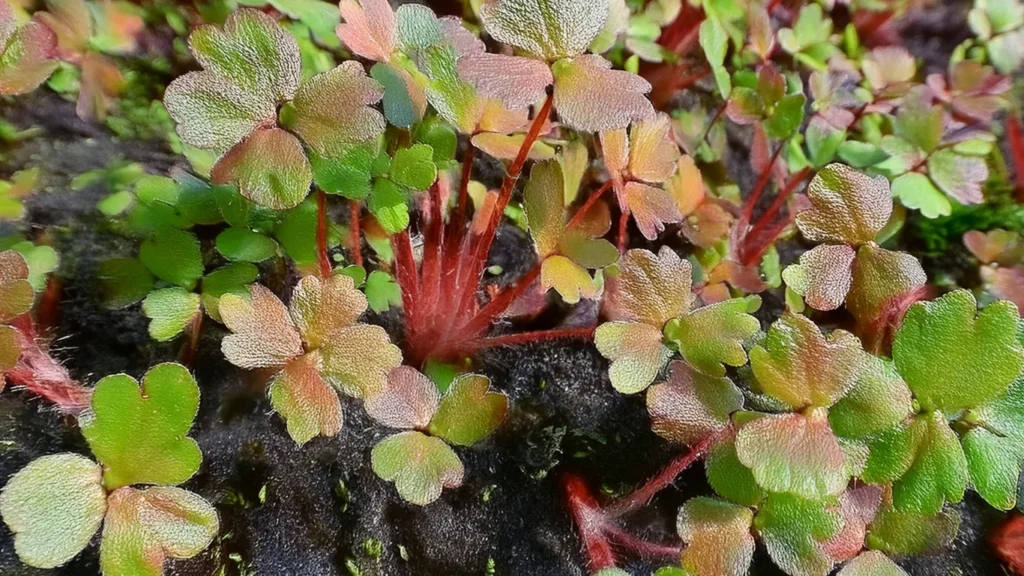
Conclusion
Phyllanthus Fluitans is a captivating aquatic plant that effortlessly enhances the beauty of any aquarium.
Its unique characteristics and ease of cultivation have become a popular choice among aquarium enthusiasts.
Whether you choose to feature it as a stunning centerpiece or incorporate it into a carefully designed aquascape, Phyllanthus Fluitans is sure to elevate the aesthetic appeal and overall health of your aquatic environment.
With its vibrant red roots and foliage, Phyllanthus Fluitans adds a touch of charm and elegance to your aquarium.
Its low maintenance requirements make it suitable for both beginners and experienced aquarists, allowing you to enjoy its beauty without needing extensive care.
Additionally, its compatibility with various aquatic species opens up a world of possibilities for creating harmonious and visually appealing tank communities.
Frequently Asked Questions
How Do I Care For Phyllanthus Fluitans In My Aquarium?
Phyllanthus Fluitans is an easy care aquatic plant that thrives in a variety of water conditions.
It requires slightly acidic to neutral water, adequate lighting, and regular doses of aquatic plant fertilizer.
Regular pruning and removal of dead leaves are also important for its maintenance.
What Are The Unique Characteristics Of Phyllanthus Fluitans?
Phyllanthus Fluitans is known for its distinctive red roots and foliage.
It provides benefits in aquatic ecosystems by oxygenating the water, reducing excess nutrients, and providing shelter for fish and invertebrates.
What Fish And Plants Can I Pair With Phyllanthus Fluitans?
Peaceful fish species like tetras, rasboras, and guppies make ideal companions for Phyllanthus Fluitans. Invertebrates like shrimp and snails can also coexist harmoniously.
When it comes to plant pairings, species like Amazon swords, Java ferns, and Anubias are often used to create beautiful aquascapes.
How Do I Propagate/Reproduce Phyllanthus Fluitans?
Phyllanthus Fluitans can reproduce both asexually and sexually.
Asexual reproduction occurs through the formation of daughter plants and runners. Sexual reproduction occurs when the plant produces flowers, which can result in the formation of seeds.
How Should I Maintain Phyllanthus Fluitans In My Aquarium?
Regular pruning, removing dead leaves, and managing pests like snails or algae are essential for maintaining the health and well-being of Phyllanthus Fluitans.
- Unveiling The Wonders Of Riccia Fluitans In Aquascapes - August 7, 2024
- Vallisneria Gigantea Var. Guide To Care And Cultivation At Home - July 31, 2024
- Vesicularia Dubyana Care & Growth Guide Tips For Beginner Gardeners - July 30, 2024
